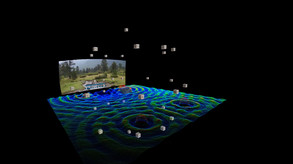Virtual Home Theater (PC)
Virtual Home Theater (VHT) is a media player and desktop mirroring software application designed for a virtual reality head mounted display connected to a PC system to simulate the perceived audio and video of a real cinema or home theater system in virtual space, adding new benefits over the real one.
With Virtual Home Theater you can:
- watch movies on a virtual big screen with virtual audio speakers (mono, stereo, 5.1, 7.1, etc.) and subtitle
- listening to stereo, 5.1 and 7.1 surround channels music as on a real audio home theater system
- listening to ambisonics audio
- watch 180 or 360 degree videos
- play non-VR games (also in stereo Side-by-Side mode and 5.1 surround audio if the game support it), browsing or watching a media stream on a virtual desktop big screen with your default Windows audio device mirrored as virtual audio speakers inside of VHT
Virtual Home Theater demo version has a limited utilization duration for media playback and desktop mirroring.
Virtual Home Theater is designed to be controlled mainly by mouse and keyboard in a sited position in front of your computer.
Virtual Home Theater has many settings controls for a customized playback experience and performance tweaking.
Some of the main features are:
- multiple audio and video formats support
- support first-, second- and third-order ambisonics in the AmbiX and FuMa formats
- HRTF-based 6 DoF sound scene rendering for listener's head orientation (roll, pitch, yaw) and position (x, y, z)
- multiple HRTFs selections to match your head auditory characteristics
- 32 audio channel masks (simulated as virtual speakers, mirroring the audio output channels from played media's audio track)
- 27 audio channel layouts for non-ambisonics audio: mono, stereo, 2.1, surround, 5.1, 6.0, 7.1, Hexadecagonal (16 audio channels), etc...
- use a spherical audio channel layout with 26 virtual speakers to play an ambisonics audio
- change the virtual speakers position
- subtitles: internal (bitmap, text) and external (.srt, .idx)
- track selection for audio, video and subtitle
- use your preferred headphones by selecting a different audio output device
- Unicode font support for non-Latin character used for subtitle and for media folder/file name
- support access to network shared folders from a NAS (Network Attached Storage) system
- azimuth, zoom level and objects apparent size change for 180 and 360-degree videos
- change the audio offset azimuth from video image for 360-degree videos
- multiple 3D video formats
- 180-degree front dome, 360-degree sphere Equirectangular (EQR) and 360-degree Equiangular cubemap (EAC) video mapping/projection
- play a Network Stream from a direct URL to media
- have a 'sneak peek' of your PC desktop (e.g. for internet browsing) when you watch a movie or listening to music within VHT
- desktop mirroring will mirror (show inside of VHT) your PC desktops screens (limited to the number of physical displays connected to your main GPU)
- desktop mirroring will mirror (simulate inside of VHT) your Windows default audio device channels output (no need to have real speakers connected to your PC) as virtual speakers
- play a non-VR 3D game in stereoscopic mode (Side-by-Side or interlaced) if the game support it
- virtual speakers layout and video screen re-position for a more comfortable experience in any sited position (e.g. lying on bed)
- show a real time 3D surface or volumetric graph representation of sound waves pressure amplitude propagation from each virtual speaker
- designed for low CPU and GPU resources use by VHT to make more CPU resource available for video decoding
- designed to render the media's video original encoded picture quality and format without degradation (original resolution, picture details, colors and frame rate)
- designed to render the media's audio track original encoded sound quality and layout without degradation or enhancements, as intended by media creator
- optimized code for speed and low installation folder size (40 MB)
Benefits of Virtual Home Theater over the real home theater system:
- is less expensive
- you don't need to build it
- you can change position, size and shape of the screen
- you can change position of the virtual audio speakers
- high contrast due to OLED technology used for some HMD displays
- no disturbed neighbors
- no heavy equipment to carry with you if you change your home location
- environment friendly due to less energy consumption than a complex audio/video system equipment
- other family members can enjoy their normal activity in the same room (no need to turn off the lights or lower the audio volume)
- no sound attenuation by obstructions
- no sound denaturation by walls reflections
- you can experience ambisonics audio
Género
utilidadesEditores
Aurel ConstantinescuDesarrolladores
Aurel ConstantinescuEnlaces
Steam
Fecha de salida
Agosto 27, 2019
SOs compatibles
Entrada
Forma de juego
Idiomas
- Textos en inglés
Comentarios (0)






